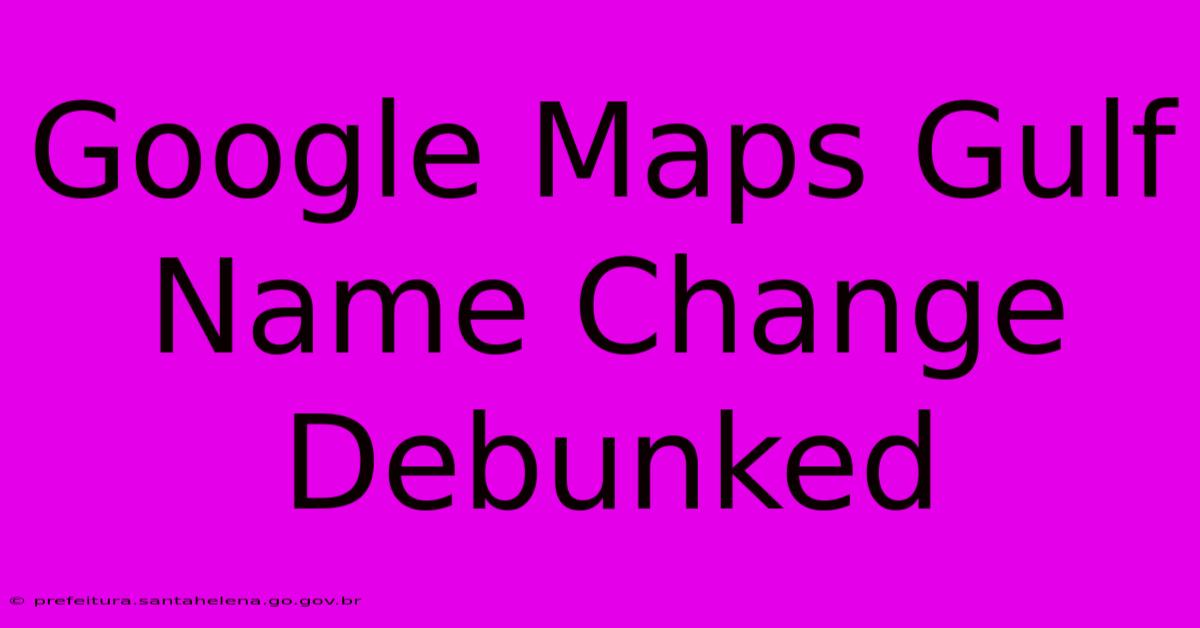Google Maps Gulf Name Change Debunked

Discover more detailed and exciting information on our website. Click the link below to start your adventure: Visit Best Website. Don't miss out!
Table of Contents
Google Maps Gulf Name Change Debunked: A Comprehensive Look at the Misinformation
The internet, a boundless ocean of information, sometimes churns up misleading currents. Recently, a wave of concern rippled across social media platforms regarding a purported name change on Google Maps, specifically affecting the geographical designation of the Persian Gulf. Claims circulated widely, alleging that Google had altered the name to "Arabian Gulf," sparking outrage and accusations of political bias. This article aims to debunk these claims, providing a comprehensive analysis of the situation and exploring the reasons behind the spread of this misinformation.
The Initial Spark: Social Media's Role in Spreading Falsehoods
The initial reports of a Google Maps Gulf name change often lacked verifiable sources. Many posts relied on screenshots, some manipulated or taken out of context, to bolster their claims. The speed at which this information spread highlights a crucial problem with social media: the ease with which false or misleading information can go viral, bypassing traditional fact-checking mechanisms. The emotional appeal of the narrative – a perceived alteration of a historically significant geographical name – further fueled its dissemination.
Examining the Evidence: What Google Actually Shows
A thorough investigation reveals that the claims of a widespread, official Google Maps name change are demonstrably false. While inconsistencies may exist in how the Persian Gulf is labeled across different Google Maps interfaces and languages, this is not a recent phenomenon and doesn't represent a systematic, official alteration. These inconsistencies often stem from the diverse naming conventions employed globally and the complexities of translating geographical terms across different linguistic contexts.
Understanding Geographical Nomenclature: A Complex Issue
The naming of geographical features is often a politically charged issue, reflecting historical claims, national identities, and geopolitical tensions. The Persian Gulf's name, for instance, has been a subject of contention for decades, with some Arab nations advocating for the term "Arabian Gulf." This long-standing debate, however, does not translate to a sudden, unilateral decision by Google to officially rename the body of water on its maps.
The Importance of Context: Language and Regional Variations
Google Maps, like many other mapping services, incorporates a multitude of data sources and user contributions. This often leads to variations in the displayed names, especially in regions with multiple languages and historical naming conventions. For example, a user searching in Arabic might see a different name displayed than a user searching in English or Farsi. This is a function of language settings and the data sourced for different linguistic regions. This variation, however, is not an official name change by Google.
Debunking Specific Claims: Analyzing Screenshot Evidence
Many of the circulating screenshots are either:
- Outdated: Screenshots might depict older versions of Google Maps, pre-dating any claimed alterations.
- Manipulated: Screenshots might be altered to show a false name, deliberately misleading viewers.
- Contextual: Screenshots might show the name "Arabian Gulf" in specific contexts, such as user-generated content or localized versions of the map, but not as a globally implemented, official change.
The Power of Verification: Utilizing Reliable Sources
To combat the spread of misinformation, it's crucial to verify information from reputable sources. Checking official Google statements, consulting established geographical databases, and cross-referencing information across multiple sources are vital steps in determining the accuracy of online claims. Relying solely on social media posts or unverified screenshots is a recipe for spreading misinformation.
The Implications of Misinformation: Real-World Consequences
The spread of false information about Google Maps' alleged name change carries potential consequences:
- Erosion of Trust: Such incidents erode public trust in both Google and online information sources in general.
- Political Tensions: Misinformation can exacerbate existing political tensions, particularly in regions with sensitive geographical naming conventions.
- Social Division: False narratives can create social divisions and fuel unnecessary conflict.
Conclusion: A Call for Critical Thinking and Information Literacy
The purported Google Maps Gulf name change is a case study in how misinformation spreads rapidly online. By critically analyzing the evidence, relying on verified sources, and promoting media literacy, we can collectively combat the spread of false narratives and maintain a more accurate and informed online environment. The inconsistencies observed in Google Maps' labeling of the Persian Gulf are not a result of a covert, politically motivated name change. They're a reflection of the inherent complexity in geographical naming conventions and the multi-faceted nature of a globally utilized mapping service. Always engage in fact-checking before sharing information online, and encourage others to do the same. Remember, responsible online citizenship requires critical thinking and a commitment to verifying information before disseminating it. The future of accurate information depends on it.

Thank you for visiting our website wich cover about Google Maps Gulf Name Change Debunked. We hope the information provided has been useful to you. Feel free to contact us if you have any questions or need further assistance. See you next time and dont miss to bookmark.
Also read the following articles
| Article Title | Date |
|---|---|
| Karoline Leavitts Press Briefing | Jan 29, 2025 |
| Noem Oversees Nyc Ice Enforcement | Jan 29, 2025 |
| Doomsday Clock Advances One Second | Jan 29, 2025 |
| Citizens Advice Shapes Med Sys Csi Deal | Jan 29, 2025 |
| Kentucky Edges Tennessee Vols 3 Point Win | Jan 29, 2025 |
| Bucks Game Schedule Updated 2024 | Jan 29, 2025 |
| Blazers Vs Bucks 125 112 Game Recap | Jan 29, 2025 |
| Anthony Davis Abdominal Injury Vs 76ers | Jan 29, 2025 |
| India Loses To England By 26 Runs T20 | Jan 29, 2025 |
| Nba Blazers Vs Bucks Live Stream | Jan 29, 2025 |
